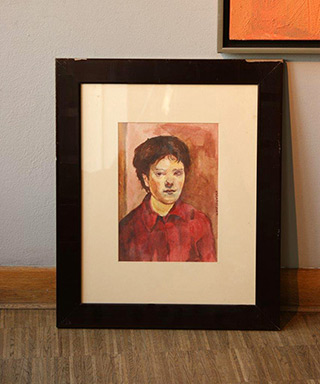Naked concentration
The painter we are writing about is immodestly young. Talent and youth are always a disquieting combination in art: too much tender attention bestowed on them may be dangerous for a young artist. Or at least that’s the general notion, and general notions are sometimes correct.
If I endeavour to write about these paintings nonetheless, it is because Aleksandra Waliszewska, despite her young age, appears singularly resilient to both praise and criticism. Her surprizingly mature art is invested with power and determination which seem to say: She knows what she’s doing and she’s always going to follow her own way. That obstinacy can be sensed in paintings and drawings, and personal contact with the artist reinforces the impression.
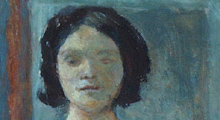
Waliszewska’s art has concentration: a painting is always directed inwards. Maybe it is because of that concentration that windows in her world do not usually open onto vast spaces, but rather tend to be small pictures within a picture, and the walls of rooms, even though we often feel their proximity, do not weigh down on us. I find paradoxes in Waliszewska’s art: there is restraint and openness, fear and courage, shyness and determination, and something like a sense of guilt towards the world. The eyes of portraits are sometimes distinct, but at other times we can not see their colour, they are like crevices through which someone is peeping at us; and so are the half-open mouths. Sometimes one eye seems lustreless, or half-closed, uncertain, which makes part of the face appear slightly deformed or blurred. Even a small deformation in a thing so fragile as a human face is alarming. This uneasiness, however, is fully controlled and becomes one of the signs of this art.
The concentration I have already mentioned is enhanced by the small size of the paintings: as if there was only room for so much under the artist’s magnifying glass: a human insect, which is neither ugly nor beautiful, it just is there. It is, however, no accident that the paintings, small in reality, seem large when in photographs. It is probably due to a sense of proportion and the courage of combining large and small elements. It must be added here that the artist, who has recently created mainly oil paintings, is no less skilful in the difficult technique of gouache.
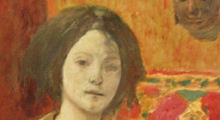
If she can solve so many problems in so little space, among them the most difficult one: that of light and shade, we have another reason to trust in her talent. Most of the paintings are testify cautious play with colour; delicate hues of brown, beige and blue prevail. Against such a wary background, a black bottle or a golden door handle appear “suddenly black” and “suddenly golden”. There are also pictures where the play with colour is bolder. If “bold” is the right word, for the sparing use of colour is a consciously chosen limitation in order to show, within its difficult framework, opulence within the bounds of poverty. Even though the same motifs and figures recur so often, and even the background tends to be similar, we never have the impression of repetitiveness, boredom or monotony. Variety in homogeneity is also one of the strengths of this art.
Among Waliszewska’s paintings there are many self-portraits, including a number of nudes: an easy subject for psychological speculations, but those can be misleading . Who knows, maybe she only paints herself because she has nobody else handy? Certainly, nudity does interest this painter - such is, after all, the age-long tradition in painting. Waliszewska’s “self-nudes” have a feeling of astonishment about them: unbelievable, so this is me, that young woman, by some incomprehensible chance endowed with a body? Even if that body can be of interest to men, the painter does not reveal whether she knows it or is on her part interested. Although she’s young and shapely, she avoids all coquetry and is ruthless with herself: “uglifies” rather than flatters. She is just constantly surprised with herself, her own face and her nudity: that the body only seems to be of one colour, but is in fact lighter and darker in different places. The subtlety with which the young artist can render the texture and colours of the body is truly impressive. But her nudity is asexual: the body of a pretty, young girl is merely an illustration of human destiny, with our civilized cave, or apartment, in the background.
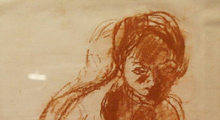
Mirrors and reflections in mirrors are also a recurrent motif in Waliszewska’s paintings. Fascination with a mirror is fascination with one’s own image reflected in indifferent, but not always cold and glassy, eyes.
Man’s animality sometimes remains hidden, but it can also be laid bare; even gentleness is lined with ferocity in these paintings. Only in one has the artist ventured into the darkness of our cave: she has painted her animal counterpart, a human-animal figure shrouded in gloom, nearly on all fours, holding out a paw-hand.
A naked person lays bare the clothing of a room. A room with its details, which are not shown tenderly , but rather hurriedly, the way we glance over them daily. Painting herself she seems to say like the philosopher: “I am someone else.” In other words, I am a mystery, to myself no less than to others. A human being in these pictures is always alone. One may say that this vast loneliness is fate’s verdict on each of us; the knowledge, whether conscious or intuitive, of the final human Solitude, is visible in the paintings. In many of the portraits’ faces I sense fear, paradoxically blended with courage, but after all, courage is fear overcome - someone who is never afraid can not be brave. Waliszewska’s art contains a challenge against the world, a defiant cry: “I will not be eaten.”

Aleksandra’s drawings have a certain carelessness about them; but it is only the seeming carelessness of an artist who, having a sure hand, knows that the unfinished can be more interesting than the perfectly polished. After all, a painter can be told by one stroke, just like a writer can be recognized by one sentence. Waliszewska has already got her line and her artistic space. The carelessness is only an appearance; it is the certainty that is real.
Czeslaw Milosz once wrote about his uneasiness when ‘the fabric of language tends continually to come unstuck from reality, and our efforts to paste them together are usually futile, though - we feel it - absolutely necessary.” Writing about Waliszewska’s painting I feel helpless in encounter with reality, which she has somehow managed to “get unstuck” from words, and here I am now, trying “absolutely necessarily”, though probably in vain, to paste words onto it.
When at a loss in describing art, the easiest way out is to talk about associations. If we were to do that - whenever, seldom, a landscape or a larger interior appears in Waliszewska’s pictures, it is reminiscent of metaphysical painting - De Chirico, for example -; in other works signs admiration for Balthus are discernible. I only mention these associations out of a sense of duty, for it’s the artist’s originality that is really important. Waliszewska has already created her own world. It is a world where the great tradition of realistic painting meets non-figurative art. She chooses the former, but is conscious of the experiences of the latter. It is a sign that the best of the young generation’s painting, in spite of everything, and particularly in spite of critics’ preferences, returns to the roots.
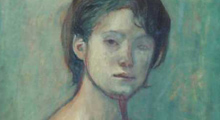
When an artist’s output is still small, like in this case, everything in it grows in importance, for good or for bad; fortunately the latter prevails in Waliszewska’s art. In a few years’ time it may turn out that a world reflected in a pocket mirror is no longer enough for the artist, that it can no longer be encompassed in the small frames of her paintings. That apart from a face and body, and a small room (which nevertheless never seems oppressive), there are also landscapes: meadows, skies, forests and the jungle of the city. There are a few paintings which suggest that she notices that world, that she can touch it with her brush, but for now prefers that brush to remain one of the attributes in her self-portraits, like in the one where, artistically lost in thought, she rests her chin on the same brush instead of her hand.
Waliszewska is standing on a threshold; nobody knows whether she will move forward or head for the place where she is now. On thing is sure: painting the way she does, she can not go back; she has tightly painted over her way of retreat. Each of the two possibilities seems both interesting and risky, like a journey; like life. Waliszewska has not had much time. but in it she has managed to create her own world, intriguing and recognizable in every bit of artistic fabric. Can one demand more of a young artist?



